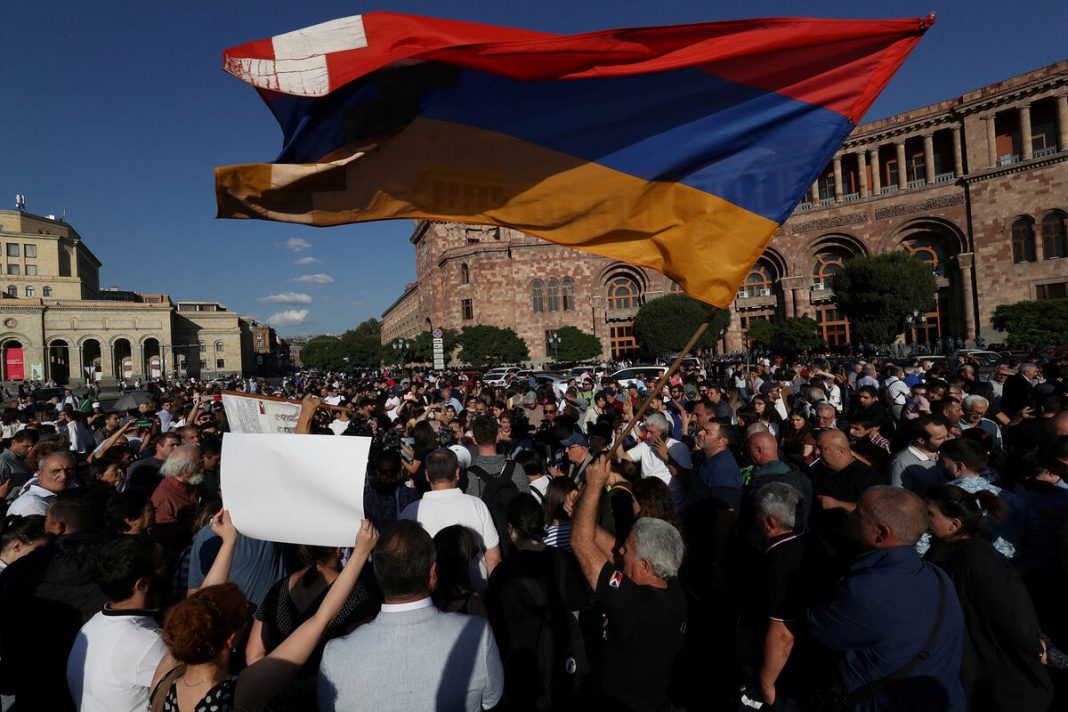Rallies have been held in Armenia for more than a month demanding the resignation of Prime Minister Nikol Pashinyan. Protesters accuse him of betraying national interests and making unjustified territorial concessions during the delimitation of the border with Azerbaijan. Since early May, rallies have moved from the border region of Tavush to Yerevan, with tens of thousands of people gathering at the most numerous, Republic Square. Street actions of disobedience are in some cases accompanied by mass detentions and police violence. So far, the authorities are not going to give up their positions, and the protesters are not strong enough to send Nikol Pashinyan to resign.
In this piece Ascolta analyzes the current political situation in Armenia, as well as examines possible options for the development of events against the background of further strengthening of protest moods in the country, as well as intensification of foreign policy pressure on the region.
This Content Is Only For Subscribers
Background
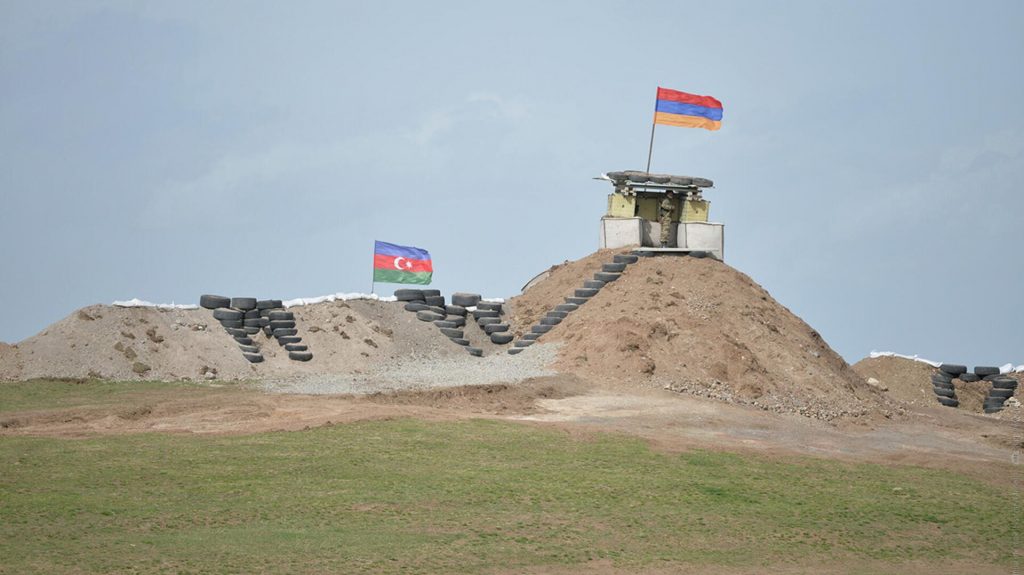
Border issues have always been a cornerstone of the Armenian-Azerbaijani peace process. After Azerbaijan’s swift military operation to restore sovereignty over Karabakh in September 2023, Baku’s territorial gestalt began to expand. Border issues covering “exclave” and “non-exclave” territories were actualized. By “non-exclave” Azerbaijan means villages controlled by Armenia. Baku planned to solve the issue of exclaves in the process of border delimitation. Special attention is paid to the territories where border shelling took place: Tavush region in the northeastern part of Armenia, Gegharkunik and Syunik regions – in the southern part. The latter remains in Baku’s focus due to the lack of direct transportation links with Nakhichevan. Baku sees the possibility of its establishment in the promotion of the Zangezur corridor project. Despite the development of the Araz corridor through Iran and the Goradiz-Jabrail-Zangilan-Agbend highway, the route through Meghri remains its unshakable goal.
The initiative to start the delimitation process from the northeastern section of the border came from Baku. On March 9, Azerbaijan demanded that Yerevan hand over four villages – Baganis Ayrum, Ashagi-Askipara (Lower Voskepar), Kheirimli and Kyzyl-Gajili. The villages are located on the border with the Gazakh region of Azerbaijan and adjacent to the Armenian settlements of Voskepar, Kirants, Voskevan, Baganis and Berkaber. Following this, Nikol Pashinyan said on March 20 that his government is ready to start delimitation of the border with Tavush region.
The Armenian authorities explained the need to adjust the border by the military threat. At a meeting with residents of one of the villages, Prime Minister Nikol Pashinyan stated that if negotiations with Baku are not started urgently, “by the end of the week” there will be war. The Speaker of the Armenian Parliament then assured that the surrender of the country’s own territories was out of the question. On April 20, the Armenian leader also announced that Russian border guards would leave the Tavush region after the demarcation of the borders with Azerbaijan.
Nevertheless, the Armenian authorities’ explanation did not inspire enthusiasm among the residents of the border regions. Local residents fear that since the problem has not been fully resolved and there are still contentious issues between Yerevan and Baku, this process will not become delimitation and a real border, but will create an opportunity to strike villages from the most favorable positions during the next military conflict. In addition, in the absence of a full and comprehensive peace agreement, the Azerbaijani armed forces may be able to deploy in the immediate vicinity of the Georgia-Armenia gas pipeline and take control of an important part of the interstate road of the same name. In addition, people were outraged by Pashinyan’s statement that he could not guarantee the safety of citizens after the transfer of the four villages.
During a meeting in Voskepara, Nikol Pashinyan also said that Armenian authorities raised a issue of 31 settlements that Azerbaijan occupied in 2020-2023, yet Baku refused to liberate them. “They say: let’s liberate a inhabited parts of a villages and afterwards discuss their vital territories. And our policy is that we should not allow a war to start. This is a reason that we have decided that we should go for a clarification of Armenia’s border in this section,” a prime minister said. Azerbaijani authorities also demand the return of four enclave Soviet villages – Tigranashen (Kyarki, on the border of Armenia’s Ararat province and Nakhchivan Autonomous Republic), Barkhudarli, Sofula, Upper Voskepar (adjacent to Voskepar).
At the same time, Baku openly said that it was ready to resolve the issue with the border territories by force. Nikol Pashinyan’s decision to transfer the four villages to Azerbaijan was criticized not only by local residents. Thus, in the evening of March 24, three supporters of the opposition “National Democratic Pole” with grenades tried to break into the police station in Nor-Nork district. They demanded Pashinyan’s resignation and accused him of territorial concessions to Azerbaijan. There was an explosion, two people were injured. According to a Gallup International poll, about 88% of Armenian residents consider the transfer of the four villages unacceptable. Thus, 79.7% of respondents called such an approach “completely unacceptable”, and 7.8% – “rather unacceptable”.
Despite the unpopularity of the decision inside Armenia, a series of mutual accusations between Yerevan and Baku, and even shelling of border areas, on April 19, the parties still agreed to begin the process of border delimitation and transfer to Azerbaijan four villages partially under Armenian control. In fact, the states tried to bring the existing borders in line with the 1991 Alma-Ata Declaration. Nikol Pashinyan made concessions, showing that Yerevan really wants peace. According to his logic, this will force Azerbaijan to follow the same direction in order not to look like an aggressor all the time.
In addition, the “April Agreement” had the great advantage that previously the territorial status quo had been formed exclusively by military means. Neither the exchange of prisoners nor meetings on European and other platforms led to any progress. The risk of escalation in the border areas increased with the increasing frequency of shelling and soldiers blowing up mines. With the agreement reached on April 19, 2024, the parties drew the first line under discussions on the contours of peace. However, even before the agreement on border delimitation, the sides had discussed the possibility of concluding a peace agreement. At the same time, Azerbaijani President Ilham Aliyev admitted that there would be no demarcation clause in the agreement, as he said such a decision would have to “wait 30-50 years”. At the same time, Baku intends to retain the territories occupied in 2021-2022 and will not “mirror” withdraw troops from the conditional border with Armenia.
The wave of the first protests
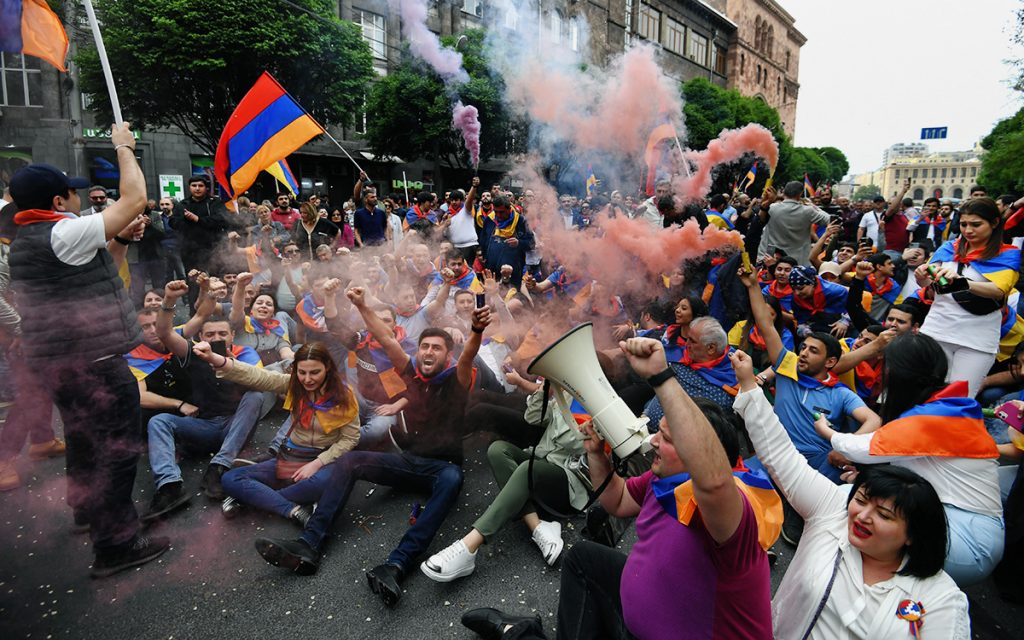
As soon as the first reports about the Armenian-Azerbaijani agreement appeared, residents of border villages, fearing that as a result of the border delimitation their houses would end up on Azerbaijani territory, opposed such concessions. In protest, residents of Tavush region repeatedly blocked roads, including the international highway that leads from Armenia to Georgia. In the village of Voskepar, where the authorities have begun the process of demining the territory that will be transferred under the control of the Azerbaijani authorities, as one of the Telegram channels wrote: “people are running straight to the fighting positions to prevent the minefields from being demined”. Clashes with police and detentions have increased. In the village of Kirants, protesters set up tents and demanded that the authorities stop the transfer of land.
Among the protesters began to appear people in military uniform, calling themselves fidayeen (by analogy with the participants of the armed struggle of the Armenian people against the Turks in the late 19th and early 20th centuries). However, the main protester and the most active participant in the protests was the rector of the Tavush Diocese of the Armenian Apostolic Church (AAC), Archbishop Bagrat (in the world Vazgen) Galstanyan. He is very popular in the region, was once the head of the AAC in Canada and was awarded Queen Elizabeth II’s Diamond Jubilee Medal in 2013. During the fighting in Nagorno-Karabakh in 2016 and 2020, the Archbishop was on the frontline and conducted services for soldiers. He became the leader of the “Tavush for the Homeland!” movement.
Armenian Prime Minister Nikol Pashinyan once again tried to calm people through social networks: “It is clear that this is a very painful issue, and it is clear that this is not someone else’s house, but my house. There is a problem of a road, a problem of a house, but I want us to fix that we are not solving the issue of any house, road or village. We are solving the issue of Armenia’s existence in the coming decades. And we will solve this issue, we have no other option.” However, Pashinyan’s comment did not clarify the situation, did not calm people down, and the protesters decided to act differently.
The procession of the cross
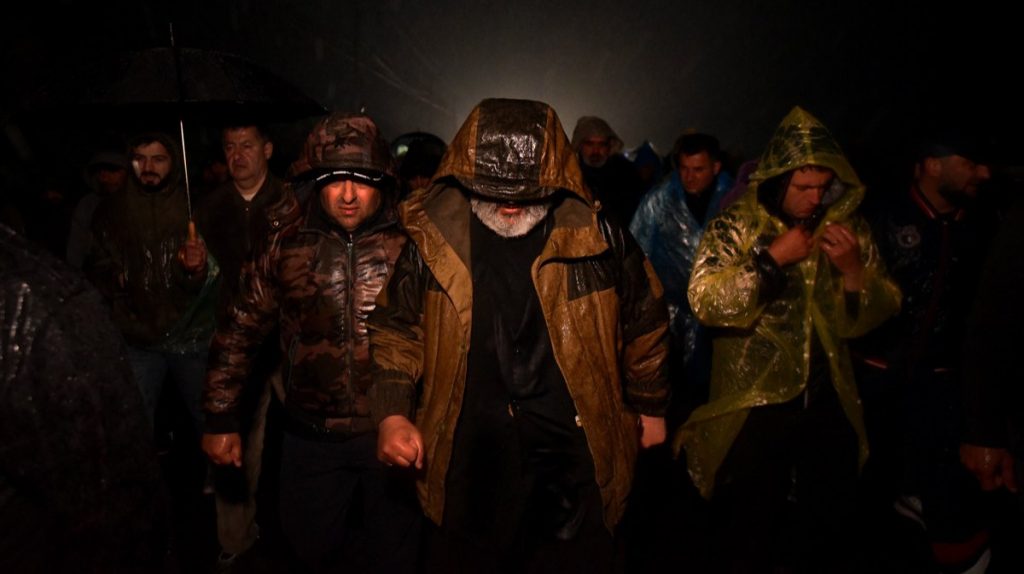
On May 4, thousands of people led by Armenian Apostolic Church Archbishop Bagrat Galstanyan marched on foot from Kirants, 160 kilometers from Yerevan, to the capital to make their demands: the resignation of Prime Minister Pashinyan; a halt to the transfer of sections of the M-16 highway to Azerbaijan; and a halt to the transfer of villages that straddle the border between Tavush and the Gazakh region of Azerbaijan. “Spiritual Armenia will defeat the new Armenia. The real Armenia must defeat the fake Armenia,” said Archbishop Galstanyan. According to him, the current march “will be victorious”: “This is a march without expectations, it is a march for homeland and honor!”. Protesters from other regions also joined the participants of the “Tavush for Armenia” movement. The opposition could not help but take advantage of the situation. The protesters were supported by politicians from the “Armenia” alliance – members of the bloc of the Dashnaktsutyun, Revived Armenia and United Armenia parties represented in the country’s parliament.
The Tavush and opposition march on Yerevan just coincided with the sixth anniversary of the 2018 Armenian Revolution. Back then, as a result of mass protests in the capital, led by opposition MP Nikol Pashinyan, the protesters managed to force the government to leave. Mr. Pashinyan took the prime minister’s chair on May 8, 2018, and he began his path to power just by walking from Gyumri to Yerevan.
At first, the Armenian authorities met the march of protesters with bewilderment. “Armenia is not making unilateral concessions, Armenia is fixing its border, and this process will continue. With maps that have a legal basis, and we fully possess these maps and legal grounds,” said Armenian National Assembly Speaker Alen Simonyan. Asked whether he fears a change of power as a result of the march from Tavush to the capital, the head of the parliament said that “a change of power in Armenia is possible only through parliamentary elections, which will be held in 2026”.
Nevertheless, the authorities actively engaged in an information attack against the marchers. Telegram channels controlled by the Armenian authorities (including “Baghramyan-26” and “Infoteka-24”) and some information resources accused Galstanyan and other leaders of the movement of being pro-Russian and wanting to return the former leaders of the country to power. In particular, Robert Kocharian, known for his closeness to Vladimir Putin. According to CivilNet, the “Haykakan Zhamanak” publication owned by Pashinian’s family, as well as Medianews, Araratnews and Civic, which are owned by deputies of the Prime Minister’s Civil Contract party, are also actively involved in the information campaign. Galstanyan has been accused of not serving but doing “business” in Tavush, and has been described as having ties to the KGB, receiving millions of dollars from the Kremlin, and other “sins”.
The archbishop himself took such criticism calmly. “God did not promise us flowers, but promised persecution. So if they attack our movement so fiercely, we are doing everything right. Their criticism has no ideological basis, it is just plain lies and propaganda,” he said. Galstanyan also recalled the shootings of priests during the Soviet era. “There was pressure during the Soviet period, too. What became of the Soviet Union afterwards? If they want to do the same, there is no difference. But what became of the church? Nothing. And the Soviet Union no longer exists and will not exist,” he said.
On May 7, Pashinyan commented on the protests for the first time. He said that the fulfillment of the protesters’ demands “will lead to war.” “The clergy’s demand to stop the delimitation process, that is, to stop creating security guarantees for Armenia, to stop the process of establishing Armenia’s sovereignty will lead to war. The forces that demand to stop the delimitation, with the assistance of some external actors, will do everything for the occupation of new territories of Armenia, use it for political changes in Armenia without elections, that is, they will establish a puppet regime with the subsequent de facto and de jure abolition of Armenia,” he said at a press conference.
At the same time, he lashed out at the church, believing that the action is actually led by the Catalikos of All Armenians, while the ultimate beneficiary is the “Karabakh clan” and personally the second president of Armenia, Robert Kocharyan. According to Pashinyan, the movement cannot be led by a representative of the church without the permission of the head of the AAC. Robert Kocharyan spoke about the scenario of power change with the help of the Church back in 2022, Nikol Pashinyan said. In response, Archbishop Bagrat Galstyan stated that “…this movement is not about me or anyone else, don’t create an idol. Today we found ourselves on the street because we created an idol, this should be completely erased from our memory”. The Archbishop touched on attempts to slander himself, “I will not stoop. They are nothing in an ideological sense compared to us. Perhaps time will come and they will regret what they have done. Time will tell.” He emphasized that in his biography there is not a single episode in which he contradicted himself, unlike those who change their minds three times a day.
Nikol Pashinyan also stated that no pressure will make him retreat from the border delimitation process, despite the fact that the Armenian and Azerbaijani authorities have not yet agreed on the signing of a peace treaty and its basic principles. According to Pashinyan, the treaty could be concluded by November 2024. “I agree with the idea of concluding a peace treaty before November. For this purpose, it is necessary to consolidate and set out in the peace treaty all the principles agreed upon during the negotiations and sign it,” he told a press conference.
At the same time, however, Ilham Aliyev said in late April that one of the preconditions for signing a peace treaty was to amend the Armenian Constitution. “The Armenian Constitution has a reference to the Declaration of Independence, which states that the so-called Nagorno-Karabakh is part of Armenia. How can we sign a peace agreement if they have such an entry in the constitution?” said Ilham Aliyev. This was not his only precondition. Aliyev also demands that Armenia remove Mount Ararat, which is now located on Turkey’s actual territory, from its coat of arms. “They have many mountains in Armenia, let them choose another one if they want,” Aliyev added.
In such conditions, Archbishop Bagrat and a thousand associates reached Yerevan on the afternoon of May 9. For the first time during the actions, he was dressed in white. As he notes – a symbol of reconciliation, victory and peace. The authorities were also “preparing” for the meeting with the protesters. In the morning of the same day, almost all law enforcement agencies of Armenia threatened the protesters with forceful actions. Thus, the National Security Service said that “any unlawful action that threatens the constitutional order will be neutralized with all legal instruments”. The Interior Ministry threatened that “any unlawful manifestation will be punished accordingly”, and the Investigative Committee directly stated about possible criminal cases.
Ultimatum of the opposition and silence of the authorities
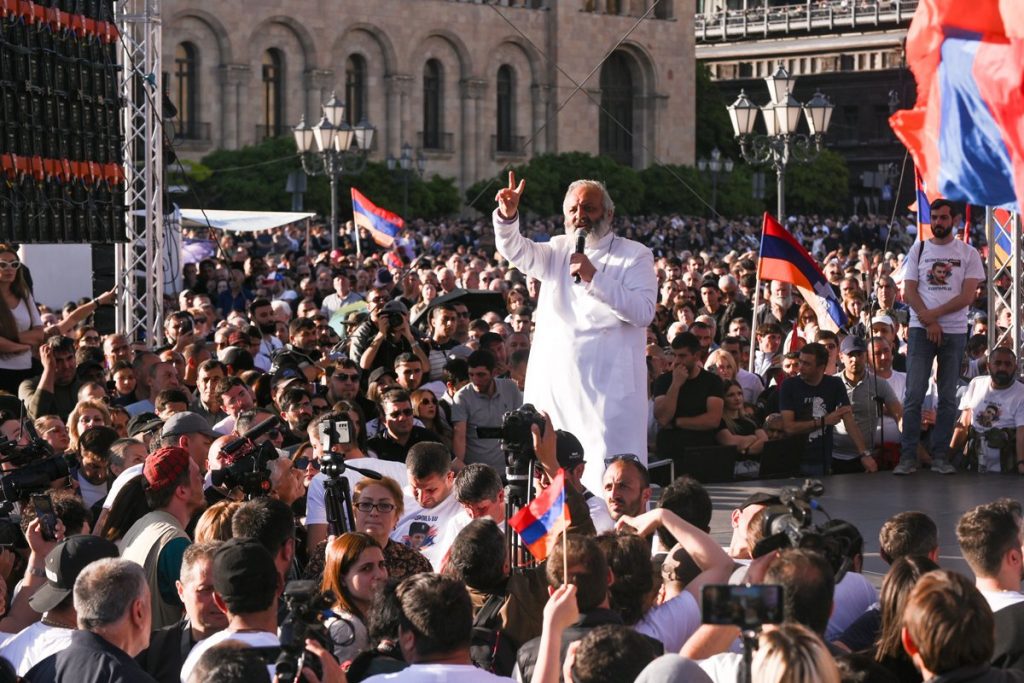
In the afternoon of May 9, from 18 to 20 thousand people gathered for a rally against the delimitation of the border with Azerbaijan, according to Armenian telegram channels. The majority of those gathered for the opposition rally were supporters of the “Tavush in the Name of Motherland!” movement. In addition, the rally was attended by former Armenian Foreign Ministers Vardan Oskanian, Ara Ayvazian, ex-Speaker of the Karabakh parliament Ashot Ghulyan, ex-President Robert Kocharian’s son Levon Kocharian.
The rally was started by Archbishop Bagrat Galstanyan, who gave Pashinyan 1 hour to resign. “Nikol Pashinyan, we give you one hour to resign. I am ready to meet within this hour and discuss all the terms of resignation. You no longer have any power in Armenia,” Mr. Galstanyan said. The Armenian authorities did not react to the ultimatum. The opposition then decided to launch impeachment proceedings against Pashinyan, but they needed to convince 20 more MPs to do so. “If the reaction is silence again, we will organize peaceful acts of disobedience,” the cleric said at the time.
Bagrat Galstanyan called to strengthen protest movements in Armenia and to start “peaceful protests in all possible places” on May 10. He recommended the participants of the rally in Yerevan’s Republic Square to return to their homes and continue the action in their localities. The Archbishop himself announced his intention to spend the night in the square, showing his support and solidarity with the movement.
Protest dynamics

On May 13, the situation began to heat up on the “day of anger” announced by the opposition. The protesters started blocking the streets from early morning. In different places of the city they pushed garbage cans and benches onto the roadway to stop traffic. In some places, straw bales were used for this purpose. There was a real duel between Telegram channels opposing the government and those supporting it. The former published posts about what, where and how the city was blocked, trying to create the impression that the capital was paralyzed. The second ones created a counter wave of publications – they wrote about how drivers were clearing the way by removing obstacles. This morning, not only Telegram channel admins and citizens dissatisfied with the authorities worked, but also the police. The number of detainees approached two hundred by evening. The press service of the Armenian Interior Ministry, however, reported that all of them were later released.
A new and unexpected turn in the protest movement happened thirteen days later, when at a regular rally on May 26, the Tavush for Homeland movement nominated Archbishop Bagrat Galstanyan as a candidate for the post of Prime Minister of Armenia. “We need a person who can take responsibility and unite everyone. A person who knows what the homeland is, knows the price of human life, of peace. A man who brought us hope and closed the door of war. This man is Lord Bagrat,” said one of the protesters. Bagrat Galstanyan asked the Armenian Church to “freeze” his 30-year service. He said he had no intention of going into politics, but was “ready to lay this sacrifice on the altar of the sacred homeland.” The 53-year-old hierarch’s energy was sufficient for street clashes with police, fiery speeches before crowds of thousands, and constant negotiations with representatives of the opposition, business and the diaspora. Judging by the archbishop’s May 29 statement, he considered Pashinyan’s replacement for himself a done deal.
After extensive consultations, the Armenian opposition approved Bagrat Galstanyan as its unified candidate. True, there were a few details that were unpleasant for him. First, the opposition does not have enough votes in the parliament to start the process of impeaching Pashinyan (it lacked 1 vote). Second, the archbishop has Canadian citizenship, which he obtained 20 years ago when he headed the Canadian diocese of the AAC. The procedure for renouncing citizenship is not quick, and Armenian laws prohibit persons with dual citizenship from holding the office of prime minister. The archbishop assured that he will do everything according to the law. “Accordingly, we will act according to the requirement of the laws and within all possibilities of the legal field. We will not allow that the head of the country who has been violating the constitution for a long time, the government that no longer has any authority, and the members of the Civil Pact, who have been violating the law and the constitution for a long time, suddenly decide to show themselves as its defenders, and we will act against it,” Galstanyan said and announced the resumption of protests throughout the country.
A new round of escalation came on May 27. There were reports in Yerevan and beyond that intercity and interstate highways were blocked for some time. Streets in Yerevan were also blocked. The police took appropriate measures to unblock and more than 100 people were detained. As Armenian media noted, there is room for thousands or tens of thousands of people to take to the streets. But the opposition is not able to involve everyone yet. First of all, the society is tired of the conflict, of the constant mobilization state. And these processes did not begin today or under Pashinyan.
The second important point is the lack of bright opposition leaders, attractive programs and understanding of the future. A simple question that Armenians often ask themselves: Pashinyan resigned and what next? Do we mobilize? Do we negotiate? What? There is no answer, and there is no alternative plan either. Galstanyan is not a politician. He expresses the pain of the Armenian society. It is not by chance that according to the polls of the International Association GALLUP in May, after the beginning of the current protests, only 6.7% said that they see Galstanyan as the head of the transitional government. No one knows how to convert this process into political steps. Therefore, the authorities continued to feel confident, preparing to counterattack. And seeing that a priest is at the head of the protests, the Armenian authorities made everyone realize that the Church, having decided to get involved in politics, can suffer from politicians.
Saints and authorities
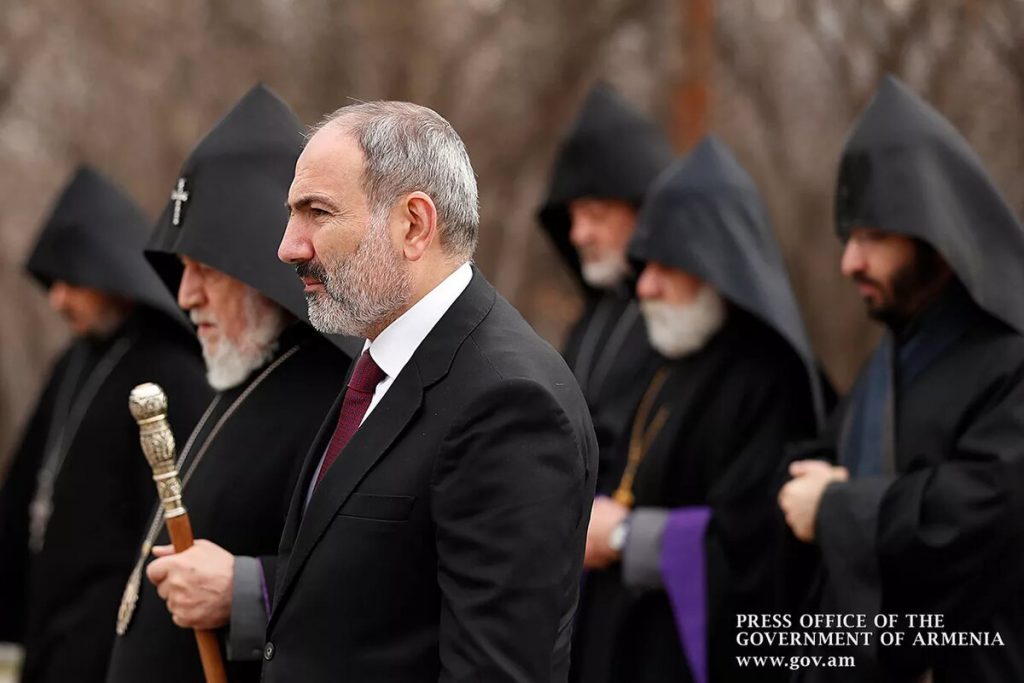
The relations between the Armenian Apostolic Church and Nikol Pashinyan did not deteriorate today. Back in 2020, when the unrecognized NKR lost most of its territory as a result of the Second Karabakh War, Catholicos Karekin II called on Pashinyan to resign. After Archbishop Bagrat Galstanyan led the protest movement “Tavush in the Name of Motherland!”, as we have already mentioned, Nikol Pashinyan blamed Catholicos Garegin II for everything and relations between the Armenian holy men and the authorities became even more tense. However, for the time being, they are just petty intrigues of the authorities. On May 28, on the Day of the Battle of Sardarapat and the Proclamation of the First Republic, dozens of policemen blocked the way of the head of the Armenian Apostolic Church and the clergymen accompanying him, trying to prevent him from visiting the “Sardarapat” memorial complex. At that time, Prime Minister Nikol Pashinyan was on the territory of the complex together with President Vahagn Khachaturyan and Parliament Speaker Alen Simonyan. Later, the Catholicos was still allowed to enter the complex, however, as stated by a number of media outlets, the authorities then removed the wreath laid in the memorial complex on behalf of the Catholicos.
Then the Speaker of the Armenian Parliament and close associate of Nikol Pashinyan, Alen Simonyan, said that “it is time to discuss and understand why the tax obligations that exist for everyone in the Republic of Armenia do not apply to the Church.”
The topic was continued by Artur Hovhannisyan, Secretary of the parliamentary faction of the ruling Civil Contract party. He stated that “all financial means that are circulating in Armenia should come out of the shadows”. And the AAC should not be an exception in this sense. Mr. Hovhannisyan reminded that the Church has tax benefits, as well as different territories, including unused ones, which can be used for the needs of the state.
“The church should assist the state to bring financial resources out of the shadows. After all, Christianity is about the absence of corruption, theft and shadow. And in our understanding, the church should be guided by this logic, not creating situations where corruption can arise,” said the MP (quoted by Arminfo).
Nikol Pashinyan did not ignore the Armenian Apostolic Church. Speaking in the parliament, he said that representatives of the Armenian clergy in the Middle Ages went to Byzantine Caesarea, where they became anointed, and returning to their homeland, they became “agents of influence”. Since then, the prime minister noted, nothing has changed. The Prime Minister promised to “solve this problem” in two-three months, instructing the Ministry of Justice to prepare documents to suspend the registration of the AAC for the period of verification of its participation in the organization of illegal mass actions, “destabilizing the society”. According to the Armenian daily The Nation, after Pashinyan’s command “face” the MPs representing the government factions moved to openly harass the clergy. In response, Armenia’s Supreme Spiritual Council, gathered in Echmiadzin, condemned the authorities for their anti-church stance and provocations against the Catholicos of All Armenians. At the same time, the Armenian Apostolic Church appealed to the opposing sides to refrain from violence, hatred, enmity and to show respect for the law in their actions, noting that the current crisis.
Protest radicalization
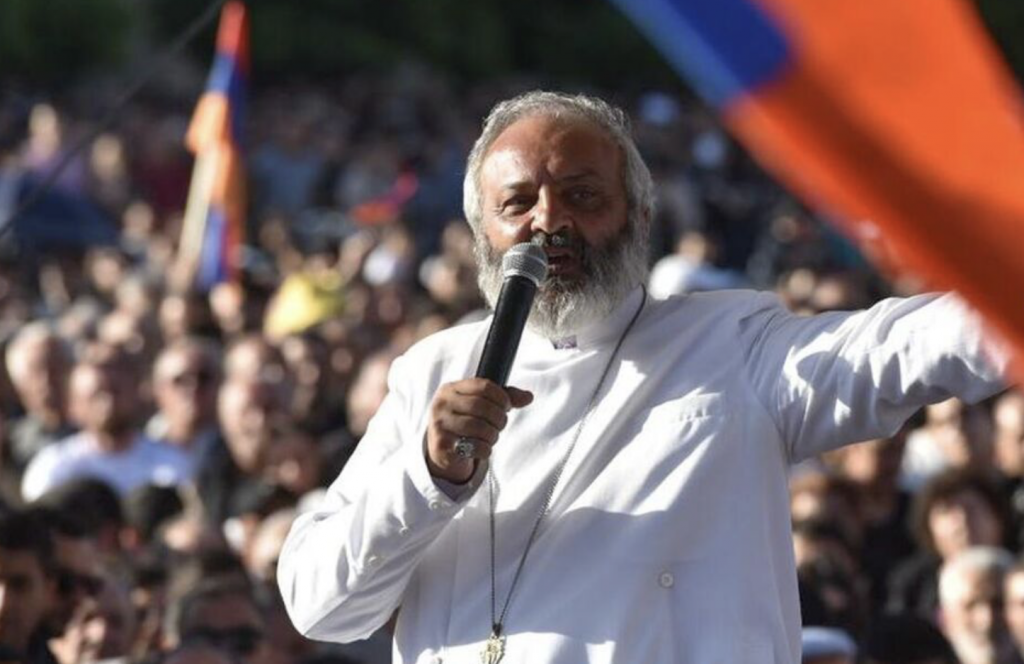
It seemed that the call of the Armenian Apostolic Church was heard, and by the end of May and the beginning of June, the protest activity began to subside. There were fewer people attending the rallies, and in general, the topic began to gradually disappear from the agenda. All the more so as flooding occurred in one of Armenia’s districts due to heavy rains, where Prime Minister Pashinyan traveled, and Armenia and Azerbaijan began withdrawing their troops in the Tavush region.
Summarizing the interim results of the protests, Archbishop Bagrat Galstanyan listed the stages already passed by the movement. The first stage was the movement from Kirants to Yerevan, which itself drew attention to the protest and served to consolidate it. During the second stage, from May 9 to May 26, the movement met with many representatives of political circles, civil initiatives, NGOs and to see the potential that exists in the country. In the third phase, as the Archbishop noted, supporters of the movement visited different government structures with the participation of the general public. According to him, “…this is the most important stage where it was fixed that today’s state structures are totally dependent on the will of one person,” Galstanyan said.
He announced a new stage of “disobedience actions” and stated that the struggle is entering its final phase. At the June 9 rally, Bagrat Galstanyan called on opposition supporters to gather the next day for a mass disobedience action. Galstanyan suggested that citizens rally for 96 hours to “impose their will” on the authorities. According to the head of Tavush in the Name of Motherland, the opposition bloc in the country’s parliament will initiate an extraordinary session on June 11 with an agenda of resigning the government and Prime Minister Nikol Pashinyan. The next step will be a decision on the formation of a new government, Galstanyan noted.
Since June 10, the acts of disobedience have resumed. The “Tavush for Homeland” movement appealed to the residents of Armenia to join them. “Dear compatriots, put aside all your affairs. Let’s solve the issue of Armenia’s future. Just three days, and we will get a recovering, just, powerful, spiritual Armenia.” However, the call had no effect and did not affect the mass of the protest movement. Then the participants of the disobedience action began to act “not in numbers, but in numbers”: one group began to block Baghramyan Avenue, where the National Assembly building is located, with tents. The second group moved towards the government dachas. However, the police prevented the second group from going to the summer houses and the protesters returned to the parliament, where they announced a sit-in. The protesters set up tents near the National Assembly building, which was cordoned off by law enforcers.
Meanwhile, the Council of the Armenian Parliament rejected the opposition’s proposal to hold an extraordinary session on the issue of no confidence in the government of Prime Minister Nikol Pashinyan. This was reported by Hayk Konjoryan, head of the ruling Civic Compact faction. “The council did not accept this proposal. And the ruling Civic Compact faction in the Council voted against this draft,” he said. Konjorian emphasized that elections will be held in 2026, News.am reported. According to him, no matter how many people take to the streets to protest, if they want a change of power, let them vote in future elections. In response, the leader of the “Tavush in the Name of Motherland!” movement, Bagrat Galstanyan, said that the government should vote in future elections. Bagrat Galstanyan called on people to come to the rally to be held near the parliament building on June 12 and added that the current government should be turned into unemployed by the protesters.
On June 12, MPs warned protesters against clashes with law enforcers and attempts to enter the parliament building. On June 12, MPs warned protesters against clashes with security forces and attempts to enter the parliament building. Bagrat Galstanyan called on the protesters to block the entrance to the parliament so that Pashinyan could not leave the National Assembly building. Scuffles broke out between the police and the protesters. The security forces started throwing light and noise grenades in the direction of the protesters. There were wounded among the protesters and journalists. According to the rally organizers, MP Asprram Krpeyan from the opposition Hayastan faction and clergyman Hrayr Hakobyan were injured by shrapnel. The Health Ministry reported 30 injured during the clash between demonstrators and police. Another 94 people were detained by police.
Under the onslaught of security forces and to avoid further bloodshed, Bagrat Galstanyan announced the end of the 96-hour rally in the center of Yerevan, after which the activists dismantled the tent city. At the June 13 rally, the archbishop said the street struggle will stop for the coming time, and he intends to hold political consultations to reformat the logic of the movement. “The ruling force will go to any lengths to retain power, but we have no right to lose. Recent events have shown that society is ready to fight,” the archbishop said.
Unsinkable Pashinyan
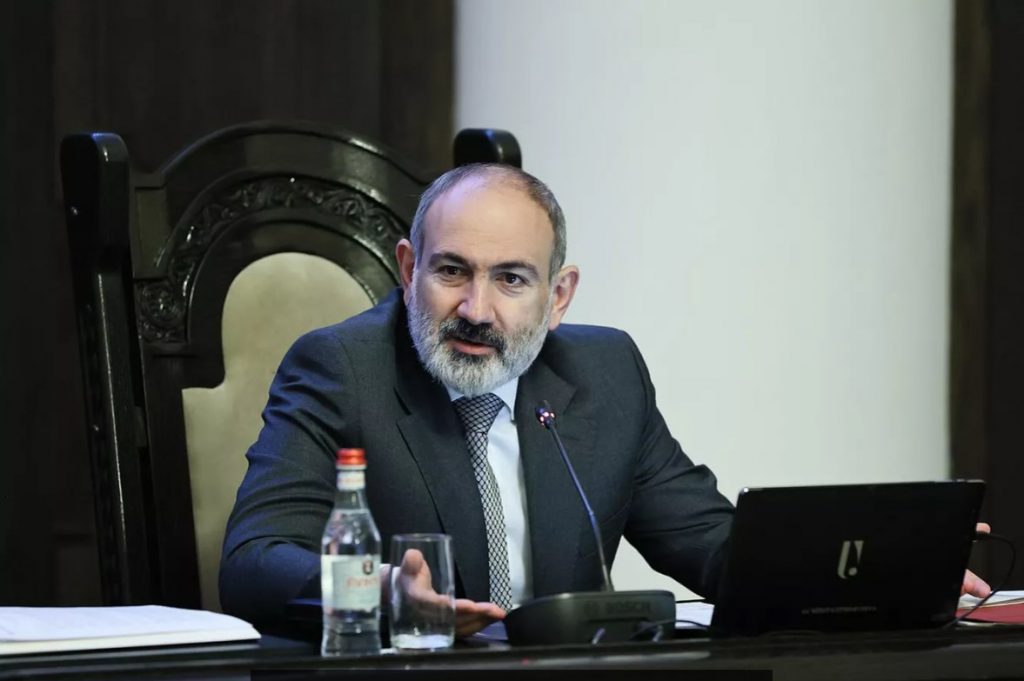
The events taking place in Yerevan are called the most serious challenge for Pashinyan during his six years in power. So far, the prime minister has stood firm, showing confidence in his abilities. Pashinyan is not accustomed to mass rallies. The current attempt by Armenia’s opposition forces to change the government is not the first. In November 2020, after losing the Karabakh war, protesters even stormed the government building and organized a pogrom in Prime Minister Pashinyan’s office. But the head of the government did not waver and did not resign. In 2021, the protests continued. Former and active military officers opposed Mr. Pashinyan, and former presidents Levon Ter-Petrossian, Robert Kocharyan, and Serzh Sargsyan called for his resignation. Mr. Pashinyan responded to this with counter-rallies. And, by the way, he was not wrong. More people gathered at them than at the opposition meetings. Then he went to early parliamentary elections. His Civil Pact party won them, and Nikol Pashinyan remained in power. The next elections are to be held in 2025. Another serious problem for the authorities were the protests in the fall of 2023 – against the background of the Azerbaijani military actions in Karabakh, their establishment of full control over the region and the exodus of all Armenians from there. But even these rallies did not take the levers of power out of Nikol Pashinyan’s hands.
The current protests are unique for Armenia. Until now, the protests against Nikol Pashinyan have been organized by politicians, including many who once worked in the government. The current protest is unique in that it is led by a church minister. This is what experts explain the massiveness of the protest. “The church has become the vanguard of the protest. And the credit of trust to it is preserved,” says Sergey Melkonyan, a researcher at the Institute of Applied Political Studies of Armenia. According to him, people saw in the church the very third force: “None of the politicians could do it, and here the church turned out to be the third force. And it is not a force that opposes the regime or the opposition. The very fact that a priest was at the head of the protest also testified to the weakness of the opposition parties and the fact that the government and the opposition equally do not enjoy the trust of the majority of citizens. This, by the way, is eloquently evidenced by the polls.
The level of support for the Armenian prime minister is now one of the lowest in his career. In December last year, i.e. even before the border delimitation started, only 17% of Armenian citizens trusted him. The results of the parliamentary opposition are even worse. The next most popular candidate for the post of acting Prime Minister is the country’s second President Robert Kocharian (1998-2008), but he is supported by only 2.5%. More than 50% of respondents do not support any of the incumbent Armenian politicians. The trend that started in 2020 – disillusionment with politics as such – persists in Armenia even now. There is a consensus in Armenian society: Pashinyan is not the only one to blame, the responsibility lies with those who came before him, who failed time after time to negotiate with Baku, who did not modernize the army, who made a mistake with the choice of allies.
Another feature of these protests was that this time they were actively supported by refugees from Karabakh. For a country of about three million people, the 100,000 Karabakh refugees who moved into the country last year is an impressive number. Although residents of the once unrecognized and now defunct Nagorno-Karabakh Republic were also citizens of Armenia, before their forced relocation they could not vote in Armenian elections. Now these people – mostly opponents of Pashinyan’s policies – have the opportunity to directly influence Armenian politics.
It must be said that the tactics, rhetoric and political demands of the movement are very similar to the tactics and demands of Nikol himself when he marched to power in 2018. He marched to the capital on foot from Gyumri, and Bagrat Galstanyan from Tavush. Mr. Pashinyan staged acts of defiance, and Priest Galstanyan is doing the same. It took Nikol Pashinyan a little over a month to win. Amid the protests, Nikol Pashinyan showed himself as a skillful and colorful orator, not devoid of acting talent. In 2018, he marched to power in the image of a revolutionary. Then, having already led the country, he became a defender of Nagorno-Karabakh. “Artsakh is Armenia. Period!” – Pashinyan proclaimed in 2019, during a visit to the then unrecognized and now defunct Nagorno-Karabakh Republic.
After the lost war, Nikol Pashinyan became a peacemaker – the government now explains its concessions to Azerbaijan, including territorial concessions, by the desire to preserve Armenia and save it from a new war. However, unlike Pashinyan, the opposition has not been able to propose a clear agenda that could be an alternative to the ruling party’s course. Moreover, while crowds of protesters are gathering in the streets, it cannot find the one missing vote to launch impeachment proceedings in parliament. At the same time, it is not even close to gathering the majority necessary for the prime minister’s resignation. This has largely determined the shrinking social base of the protests and the government’s confidence that it is in full control of the situation inside the country.
Nikol Pashinyan and his team, always sensitive to public sentiment, not only keep pace with public opinion, but in some cases even shape it. Today Pashinyan is playing the “Russian card” very skillfully. The mass disappointment with Russia and Putin and the frankly anti-Russian sentiments of Armenian citizens play into Pashinyan’s hands. Moscow is blamed for “refusing to defend Armenia against Azerbaijani aggression.” Taking advantage of this, Pashinyan is trying to create a situation in which the majority of Armenians must be convinced that there is simply no alternative to a close partnership with the EU and even NATO. In addition, by moving Armenia away from Russia, he is making the opposition, many of whose representatives are known for their close ties with Russia, even weaker, depriving them of the opportunity to propose any alternative plan to “save the country”. At least by mobilizing internal resources, at least with the help of external forces.
For the first time in modern history, Armenia is actively diversifying its foreign policy, developing a wide variety of partnerships that have nothing to do with Russia. Step by step, Pashinyan is bringing the topic of new allies – the EU and the United States – to the forefront. In the popularity ranking of Armenia’s key security partners, France is in first place (50%), followed by the U.S. and Iran (named by 46% each).
However, for now Nikol Pashinyan prefers not to talk about NATO, realizing the lightning that will come from the Kremlin. However, if one considers that withdrawal from the CSTO is almost a done deal, and the perception of Azerbaijan as a military threat in Armenia will persist even after signing a treaty with Baku, Yerevan has no alternative to rapprochement with NATO. Especially since the changes in Georgia’s policy, which is increasingly oriented towards China and Russia, and the authoritarian regime in Azerbaijan potentially turn Armenia into the alliance’s main ally in a strategically important region. But this is probably a distant prospect. Much closer is the activation of the European direction.
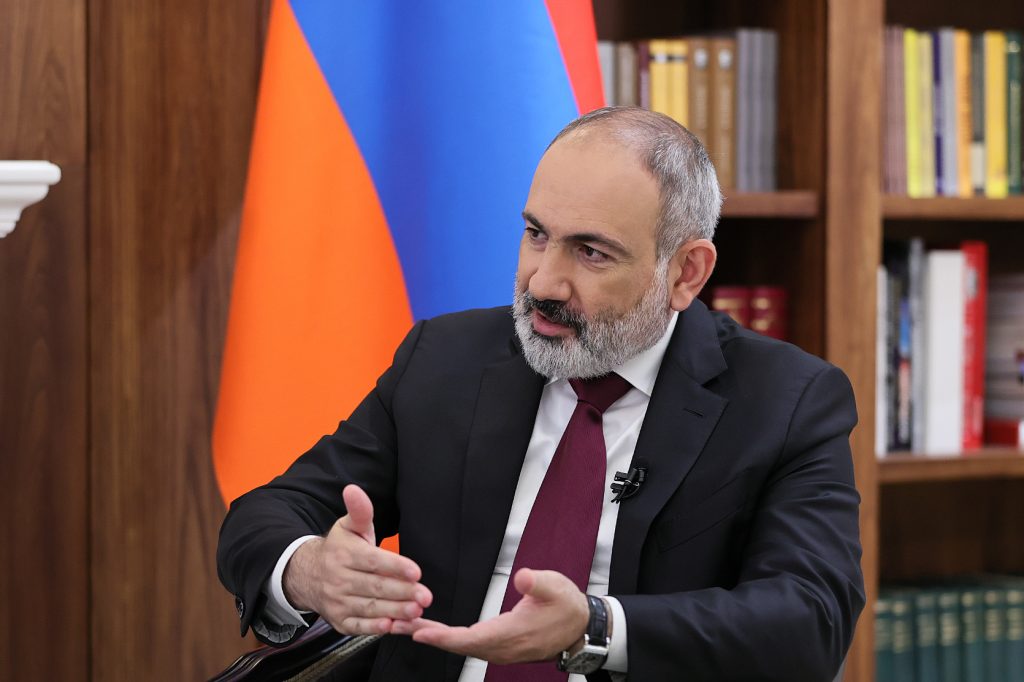
In mid-February, EU diplomatic chief Josep Borrell said that the EU and Armenia had decided to start working on an “ambitious” expansion of bilateral cooperation. Complicating matters is the EU’s Eastern Partnership mechanism with the three South Caucasus countries, Ukraine, Moldova and Belarus. Ukraine and Moldova now expect EU accession talks to start soon, Georgia has become a candidate for accession. Pashinyan’s government expects to lead the country down the same path, especially since Russia’s aggression against Ukraine has increased the EU’s focus on its neighbors and assistance to those willing to distance themselves from Moscow. “Pashinyan and his team, it seems to us, want to turn Armenia into a kind of analog of Saakashvili-era Georgia,” an informed European diplomat told DW. – Accelerated modernization, strengthening ties with the EU, and potentially a visa-free regime, like Georgians, Ukrainians and Moldovans”. Indeed, visa liberalization is constantly talked about at various EU-Armenia meetings. Although a visa-free regime is unlikely to be introduced in the next year or two.
Against the backdrop of the protests, Nikol Pashinyan made several striking statements that reinforce his desire to change his foreign vector. First of all, his statement on withdrawal from the CSTO. “We will withdraw. We will decide when to withdraw. And in your opinion, what should be the next step? We will not go back! There is no other way,” Pashinyan said during a government hour in parliament. He accused the country’s former authorities of joining a “bubble alliance” whose members “with Azerbaijan were planning a war against us.” Back in February, Pashinyan said Armenia had “frozen” its participation in the CSTO and in May suspended its funding in the organization as well, claiming that two CSTO member countries were involved in preparing for a war with Azerbaijan in Nagorno-Karabakh in 2020.
On the eve of Pashinyan’s announcement of withdrawal from the CSTO, Armenia announced that it would raise its relations with the United States to the level of strategic partnership. This implies Washington’s assistance in reforms in the economic and defense spheres, but does not mean direct intervention of the U.S. Army in a possible conflict. U.S. Undersecretary of State for European and Eurasian Affairs James O’Brien also announced Washington’s plans to strengthen security relations with Yerevan.
A little earlier, the head of Yerevan’s Nor-Nork administrative district, Tigran Ter-Margarian, accompanied by the Armenian Ambassador to Kiev, arrives in Bucha, where they lay wreaths at a memorial sign in honor of those who died at the hands of the Russian occupiers and hand over humanitarian aid to the city council. The angry reaction of the Russian Foreign Ministry to this visit was simply ignored in Yerevan.
The “cherry on the cake” was Pashinyan’s demarche against Alexander Lukashenko. The reason is the close relations between Minsk and Baku, the supply of Belarusian Polonez systems to the Azerbaijani army and Lukashenko’s harsh statements after the war, who called the war in Nagorno-Karabakh “liberating” during his visit to Azerbaijan. “I also remembered our conversation before the war, before your war of liberation, when we were philosophizing over lunch, the two of us. Then we came to the conclusion that it is possible to win the war. It’s important. It is very important to hold on to this victory,” Lukashenko said in May.
Armenian Prime Minister Nikol Pashinyan has allowed the country’s position on participation in the CSTO to change if Belarus leaves the organization or Alexander Lukashenko apologizes to the Armenian people for supporting Azerbaijan in the war in Nagorno-Karabakh, Armenpress and News.am report. “One of the leaders of the CSTO states that he participated in the preparation of the war, encouraged, believed and wished victory to Azerbaijan. And after that I will go with the head of Belarus in the CSTO format to discuss something?” – Pashinyan said at a parliamentary session.
Pashinyan recognized that contacts between the countries would remain within the framework of the CIS and the EAEU. Nevertheless, the prime minister emphasized that neither he nor any other official representative of Armenia would visit Belarus as long as Lukashenka was in charge of the country.
The winding down, albeit temporarily, of street protests speaks eloquently for the Pashinyan government, which is firmly on its feet. Work on external and internal fronts is bearing fruit. The police are still willing to follow orders, the ruling party MPs are still willing to vote the way they should, and the majority of the population is anxiously but without much sympathy watching. If anything can change the current equilibrium, it is an unambiguous reaction of external players or the transition of the entire structure of the Armenian Apostolic Church into active resistance to the authorities. However, this is unlikely.
So, for now, Pashinyan is absolutely sure that nothing threatens his power. The best proof of this is the vote of no confidence in the government, which the opposition appointed for June 17, and which the PM’s close associate Alen Simonyan approved after short consultations. The pro-government MPs, who, as we remember, are in a solid majority, even have room for maneuver here – to come, but vote against it, or to disrupt the session by skipping it with the whole body.

